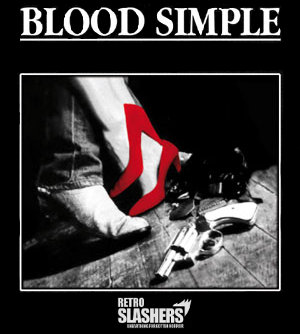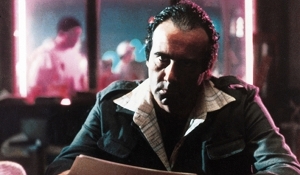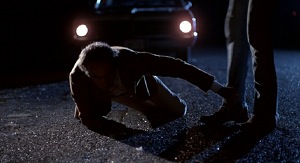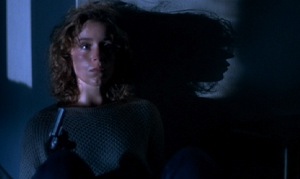
The slasher movie had become such a dominant force at the box office during the early eighties that, despite the critics refusing to acknowledge its importance, they soon began to influence mainstream cinema. Both Ridley Scott’s Alien and James Cameron’s The Terminator, two highly respected genre classics, had been influenced by John Carpenter’s Halloween, and when the Coen Brothers made their feature debut with the neo noir thriller Blood Simple, they were as influenced by contemporary horror as they were by the literary works of Dashiell Hammett and James M. Cain. Seamlessly jumping between drama, black comedy and horror, their first offering would most commonly be regarded as a modern noir piece, with many critics dismissing its slasher roots and instead comparing it to the likes of The Postman Always Rings Twice and Double Indemnity (both of which it clearly owed a debt to).
 In a dark and soulless Texan town, Abby (Frances McDormand) is unhappily married to disgruntled bar owner Marty (Dan Hedaya) and living a dead end life. One night, she catches a ride from Ray (John Getz), one of her husband’s employees, and the two eventually decide to get a room in an out-of-the-way motel. But the driver of the car that had been tailing them is Loren Visser (M. Emmet Walsh), a private investigator that Marty had hired due to his wife’s frequent infidelity. Visser presents Marty with photographs of the two having sex and the following evening Ray appears at the bar to collect the money he is owed. Marty informs him of Abby’s regular indiscretion and then threatens that if he ever returns to the bar he will kill him. Abby takes shelter at Ray’s house, prompting Marty to taunt them with regular silent phone calls. He eventually appears at the home and confronts his wife, dragging her out onto the lawn but his aggression soon causes her to fight back, sending her foot into his groin. A moment later, Ray appears at the door with a gun and Marty heads back to his car, humiliated.
In a dark and soulless Texan town, Abby (Frances McDormand) is unhappily married to disgruntled bar owner Marty (Dan Hedaya) and living a dead end life. One night, she catches a ride from Ray (John Getz), one of her husband’s employees, and the two eventually decide to get a room in an out-of-the-way motel. But the driver of the car that had been tailing them is Loren Visser (M. Emmet Walsh), a private investigator that Marty had hired due to his wife’s frequent infidelity. Visser presents Marty with photographs of the two having sex and the following evening Ray appears at the bar to collect the money he is owed. Marty informs him of Abby’s regular indiscretion and then threatens that if he ever returns to the bar he will kill him. Abby takes shelter at Ray’s house, prompting Marty to taunt them with regular silent phone calls. He eventually appears at the home and confronts his wife, dragging her out onto the lawn but his aggression soon causes her to fight back, sending her foot into his groin. A moment later, Ray appears at the door with a gun and Marty heads back to his car, humiliated.
Meeting up with Visser, Marty says that he wants both Abby and Ray killed. Concerned that the crazed Marty could get them both caught, he is at first reluctant but finally agrees for the right price. Taking photos of the sleeping couple and modifying them to make him appear dead, Visser takes Abby’s gun and heads over to the bar, where he claims his $10,000 fee, before shooting Marty and leaving the gun. Soon afterwards, Ray arrives to demand his wages but instead finds him slumped in his chair with Abby’s gun in front of him. Believing that she has killed him, Ray sets about cleaning up the scene of the crime and disposing of the corpse, taking the body out into the desert but, as he is about to put him in the ground, Marty comes to and attempts to crawl away. Realizing that it is too late to turn back, he drops him into a shallow grave and buries him alive.
 Ray is now convinced that Abby was the one responsible and is plagued with guilt for his part in it. This distrust is slowly driving them both apart and when Ray arrives at her new apartment to reassure her that he has cleaned up the mess she doesn’t understand. But matters become worse when Visser discovers that he has left an important piece of evidence – his lighter – in Marty’s office, something that could incriminate him. Ray becomes increasingly paranoid that someone is following him and his fears soon become a reality when Visser comes after them, determined to tie up all loose ends in order to protect himself, but when he shoots Ray with a sniper rifle from an adjacent building, he then makes his way into Abby’s apartment to take care of business, forcing her to defend herself from the intruder.
Ray is now convinced that Abby was the one responsible and is plagued with guilt for his part in it. This distrust is slowly driving them both apart and when Ray arrives at her new apartment to reassure her that he has cleaned up the mess she doesn’t understand. But matters become worse when Visser discovers that he has left an important piece of evidence – his lighter – in Marty’s office, something that could incriminate him. Ray becomes increasingly paranoid that someone is following him and his fears soon become a reality when Visser comes after them, determined to tie up all loose ends in order to protect himself, but when he shoots Ray with a sniper rifle from an adjacent building, he then makes his way into Abby’s apartment to take care of business, forcing her to defend herself from the intruder.
Brothers Joel and Ethan Coen had first developed an interest in filmmaking whilst in their teens and had saved up enough money from mowing lawns to enable themselves to purchase a Vivitar Super 8 camera. Eventually, Joel decided to take his passion further and in 1974 enrolled at the New York University, where she shot a thirty-nine minute thesis entitled Soundings, about a deaf woman who fantasises about her lover’s roommate, vocalising her lust as her partner is also unable to hear. Once Ethan had graduated from Princeton University, he relocated to New York where he came a typist and occasional writer for the hit cop show Cagney and Lacey. Joel, meanwhile, attempted to enter the industry as an editor-for-hire, working on the likes of Frank LaLoggia’s Fear No Evil and Romano Scavolini’s Nightmare in a Damaged Brain (of which he would be fired from after just two weeks, due to poor time keeping).
 But the project that would have a profound effect on his career was when he was hired by twenty-one year director Sam Raimi to help cut his first feature film, The Evil Dead. Joel was suitably impressed by how the young filmmaker had self-financed the movie by raising the necessary funds through investors (including dentists and lawyers). Utilising a similar approach, the brothers decided to shoot a three-minute trailer as a ‘teaser,’ in an effort to entice potential investors into parting with their money (a technique that Raimi had previously achieved when his thirty-two minute short Within the Woods was produced as a precursor to The Evil Dead). Drafting in the talents of first-time cinematographer Barry Sonnenfeld (who, after lensing three movies for the brothers, would become a director in his own right with such blockbusters as The Addams Family and Men in Black), the Coens would storyboard their film in explicit detail to create a brief trailer to show what they intended to do the money.
But the project that would have a profound effect on his career was when he was hired by twenty-one year director Sam Raimi to help cut his first feature film, The Evil Dead. Joel was suitably impressed by how the young filmmaker had self-financed the movie by raising the necessary funds through investors (including dentists and lawyers). Utilising a similar approach, the brothers decided to shoot a three-minute trailer as a ‘teaser,’ in an effort to entice potential investors into parting with their money (a technique that Raimi had previously achieved when his thirty-two minute short Within the Woods was produced as a precursor to The Evil Dead). Drafting in the talents of first-time cinematographer Barry Sonnenfeld (who, after lensing three movies for the brothers, would become a director in his own right with such blockbusters as The Addams Family and Men in Black), the Coens would storyboard their film in explicit detail to create a brief trailer to show what they intended to do the money.
Having witnessed the likes of Raimi, LaLoggia and, to a lesser extent, Scavolini, produce successful horror films on limited budgets, Joel decided that there was clearly a market for cheap exploitation flicks. Yet, they had both developed an appetite for crime fiction and were passionate about developing something similar to the works of Cain. Thus, their first film would blend elements from both film noir and horror, as the story of a double-crossing love triangle would result in bloodshed. The Coens’ had previously penned a screenplay entitled The XYZ Murders (which would eventually be shot by Raimi under the title Crimewave), but their limited resources dictated that the scope of their story should be restricted to as few characters and locations as possible. The film’s title would be a reference to Red Harvest, a 1920’s crime novel by Hammett that had first been published as a serial in the popular magazine Black Mask throughout 1928 and ’29, with one passage from the book describing man’s erratic behaviour after committing a murder as being ‘blood simple.’
 The film would be heavily influenced by the great Alfred Hitchcock, most notably during the scene in which Ray attempts to clear up the bloodied aftermath of Marty’s supposed murder. Whereas Psycho had featured a relatively brief and straightforward clean up after the shower scene, in Blood Simple the character’s inadequacies results in twenty minutes of the movie being dedicated to his attempted disposal of the body. Not only is this the darkest and most bloody sequence of the film, it is also the most amusing, showcasing the deadpan humour that they would later employ with the likes of Barton Fink and The Big Lebowksi. The segment that the influence of the slasher film is so evident is during the last fifteen minutes, immediately after Ray’s murder, when Visser breaks into Abby’s apartment and attempts to kill her. Trapped in a darkened room with nowhere to escape, death closes in on her as each bullet hole that burst through the wall casts a new light through the blackness of the room. The Coen Brothers have never been coy about how much of a part the horror genre played on the writing and making of Blood Simple, and whilst critics often refuse to admit it, the movie was most definitely a film noir/slasher hybrid that showed the conventions of the genre need not be generic and predictable.
The film would be heavily influenced by the great Alfred Hitchcock, most notably during the scene in which Ray attempts to clear up the bloodied aftermath of Marty’s supposed murder. Whereas Psycho had featured a relatively brief and straightforward clean up after the shower scene, in Blood Simple the character’s inadequacies results in twenty minutes of the movie being dedicated to his attempted disposal of the body. Not only is this the darkest and most bloody sequence of the film, it is also the most amusing, showcasing the deadpan humour that they would later employ with the likes of Barton Fink and The Big Lebowksi. The segment that the influence of the slasher film is so evident is during the last fifteen minutes, immediately after Ray’s murder, when Visser breaks into Abby’s apartment and attempts to kill her. Trapped in a darkened room with nowhere to escape, death closes in on her as each bullet hole that burst through the wall casts a new light through the blackness of the room. The Coen Brothers have never been coy about how much of a part the horror genre played on the writing and making of Blood Simple, and whilst critics often refuse to admit it, the movie was most definitely a film noir/slasher hybrid that showed the conventions of the genre need not be generic and predictable.

2 Responses to Blood Simple (1984)